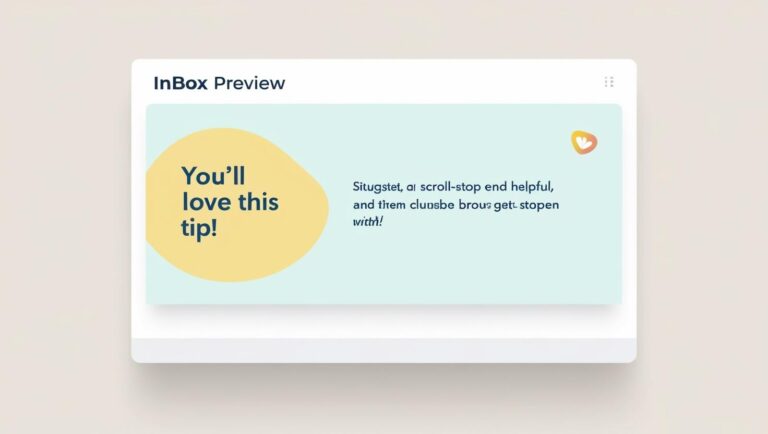Email Isn’t Dead — You’re Just Using It Wrong
If you’ve been told that “email is dead,” take a moment to check your inbox. Chances are, you’ll find a handful of newsletters, updates, welcome emails, and special offers waiting for you. Email isn’t just alive — it’s thriving.
The truth is, email marketing has evolved. It’s no longer a simple blast of announcements or a tool for spamming inboxes. Today, it’s strategic, personal, and incredibly effective — especially for small businesses that want to build trust, nurture relationships, and convert readers into clients.
And yet, so many small businesses aren’t using it to its full potential. Some send emails only sporadically, others try to imitate corporate newsletters and sound stiff or impersonal, and many don’t send anything at all.
This isn’t because email is “dead.” It’s because it’s misunderstood. In this post, we’ll break down why email marketing still works, how small businesses can use it effectively, and what a practical, manageable system looks like.
Why Email Still Works (And Always Will)
Unlike social media algorithms, paid ads, or third-party platforms, email is a channel you own. When someone subscribes to your list, you have a direct line of communication with them. No gatekeepers, no distractions, no constantly changing rules.
This alone gives email an advantage over other marketing channels, but the benefits go deeper.
Email builds trust and intimacy. Unlike a social post that scrolls past in seconds, emails land in someone’s inbox — a space they’ve chosen to enter. Over time, this repeated presence creates familiarity, trust, and loyalty.
It’s personal. Permission-based emails reach people who’ve opted in, meaning your messages are wanted. This dramatically increases engagement compared to cold social media outreach or ad campaigns.
It’s cost-effective. Even the smallest business can implement email marketing without a big budget. Platforms like MailerLite or Brevo allow you to send thousands of emails for a fraction of the cost of paid ads, with automation features that save time.
It’s automatable — without losing the human touch. Email allows you to craft sequences that feel personal, provide value, and guide readers toward a next step.
Yet despite all this potential, many small businesses fall into common traps. Emails are sent only when there’s something to sell. They’re long, dull, or filled with jargon. Or worse, a new subscriber signs up and never hears from the business again. This is a missed opportunity — one that’s entirely avoidable.
Email Marketing for Small Businesses: What It Should Look Like
The misconception that email is “complicated” or “corporate” often keeps small business owners from taking action. The truth is, effective email marketing doesn’t require funnels with dozens of automated paths or complex segmentation from day one. You just need a simple, repeatable system.
Welcome Sequences: First Impressions Matter
The welcome sequence is the most important part of your email strategy. This is what new subscribers receive when they first sign up — and it sets the tone for every interaction afterward.
A good welcome sequence introduces your business, shares your values, provides immediate value, and encourages the reader to engage. At minimum, it should include:
A warm greeting: why they signed up, what to expect, and a little about you
Something valuable: a free guide, a tip, a story, or insight related to your industry
A personal message: sharing what you believe about your business, your work, or your approach
A light call-to-action: a gentle nudge to read a blog, reply to the email, or book a consultation
For example, a small business offering graphic design services could include in their welcome sequence a downloadable checklist for “Branding Mistakes to Avoid,” an introduction to the designer’s philosophy, and an invitation to schedule a free consultation. All of this can be automated, giving new subscribers an immediate, positive experience.
Regular Broadcasts: Keep Showing Up
Once your welcome sequence is in place, the next step is consistent broadcasting. This doesn’t have to be daily or even weekly — twice a month can be enough if you’re consistent and purposeful.
Think of broadcasts as a way to maintain a relationship with your list. Your goal is to remain visible, helpful, and relevant. Here’s an example of a monthly rhythm:
Week 1: Value-focused content — share a quick tip, insight, or solution to a common problem. For instance, “3 simple ways to improve your website usability this week.”
Week 2: Proof or results — showcase a client story, testimonial, or outcome. For example, “How one client doubled their inquiries with a simple website tweak.”
Week 3: Personal update — share lessons learned, behind-the-scenes moments, or small wins from running your business. For instance, “This month taught me the importance of batching tasks for productivity.”
Week 4: Offer or gentle call-to-action — invite readers to engage, book a service, or access a resource. Example: “Limited spots available for our next workshop — secure yours today.”
This rhythm keeps your audience engaged without overwhelming you. And much of this content can be repurposed from blog posts, social media updates, or even client conversations, saving time while maintaining relevance.
Campaigns: For Special Occasions
In addition to regular broadcasts, campaigns are short-term email sequences for launches, seasonal offers, or limited opportunities. They don’t need to be complex. A well-crafted campaign of 3–5 emails can generate significant results when done thoughtfully.
For instance, a small wellness business could run a seasonal campaign for a new program:
Email 1: Teaser — introduce the program and why it’s valuable
Email 2: Behind-the-scenes — share how the program was created and the benefits participants can expect
Email 3: Social proof — testimonials or success stories from previous participants
Email 4: Final invitation — reminder of limited availability or early bird offers
Campaigns give your list clear, actionable steps while keeping your business top-of-mind during a critical period.
Common Email Marketing Mistakes to Avoid
Even with the right tools, small businesses often make avoidable mistakes that limit the effectiveness of email marketing.
Avoid sending emails that are:
Too long or formal: Readers skim emails. Keep them concise and conversational.
Sales-only: Nurturing relationships is as important as making offers. A list that only hears from you when you’re selling will quickly disengage.
Ignored after signup: Not following up with a welcome sequence is one of the biggest missed opportunities. Subscribers expect to hear from you.
Unreadable on mobile: Half of your audience is opening emails on a phone. Format for mobile to ensure readability.
And please, resist generic subject lines like “Newsletter #43.” Make every email feel purposeful and relevant to your audience.
Real Results, Even With a Small List
You don’t need 10,000 subscribers to make email work. Engagement matters more than list size. A list of 200 highly engaged subscribers can be more valuable than 5,000 inactive ones.
A small, engaged list can generate:
Clients: People who have already shown interest are more likely to convert
Referrers: Satisfied readers often recommend your business to others
Advocates: Subscribers who trust you will share your content and spread the word
Email marketing is about nurturing relationships you’ve already started. It’s not shouting at strangers; it’s deepening connections.
How Small Businesses Can Make Email Work
If you’re thinking, “This sounds great, but I don’t have time,” know that you’re not alone. Many small business owners struggle to find the bandwidth for email marketing. That’s why a simple system is key.
Start by choosing the right platform. MailerLite, Brevo, or similar tools offer user-friendly templates, automation features, and manageable pricing for small businesses.
Next, focus on your welcome sequence. Crafting an automated series that nurtures new subscribers immediately pays off in engagement and conversions.
Then, set up your broadcast rhythm. Whether you send emails weekly or twice a month, consistency matters more than volume.
Finally, consider templates for your emails. Pre-formatted structures save time, reduce stress, and make it easy to maintain a consistent voice.
For example, one small design agency we work with set up a single template for value emails and proof emails. Every new piece of content could fit into this template, meaning they could draft and send an email in 15 minutes without overthinking design or layout.
Bringing It All Together
Email isn’t dead. It’s alive, evolving, and one of the most powerful tools small businesses have. The key is to use it strategically:
Make a strong first impression with a welcome sequence
Maintain engagement with consistent broadcasts
Leverage occasional campaigns for promotions or launches
Avoid common pitfalls that reduce trust or engagement
Focus on relationships rather than list size
Even a small, engaged email list can generate real results — clients, referrals, and advocates — if approached correctly.
Small business owners who treat email strategically, with authenticity and consistency, find that it’s not just an additional marketing channel — it becomes the backbone of their client relationships.



